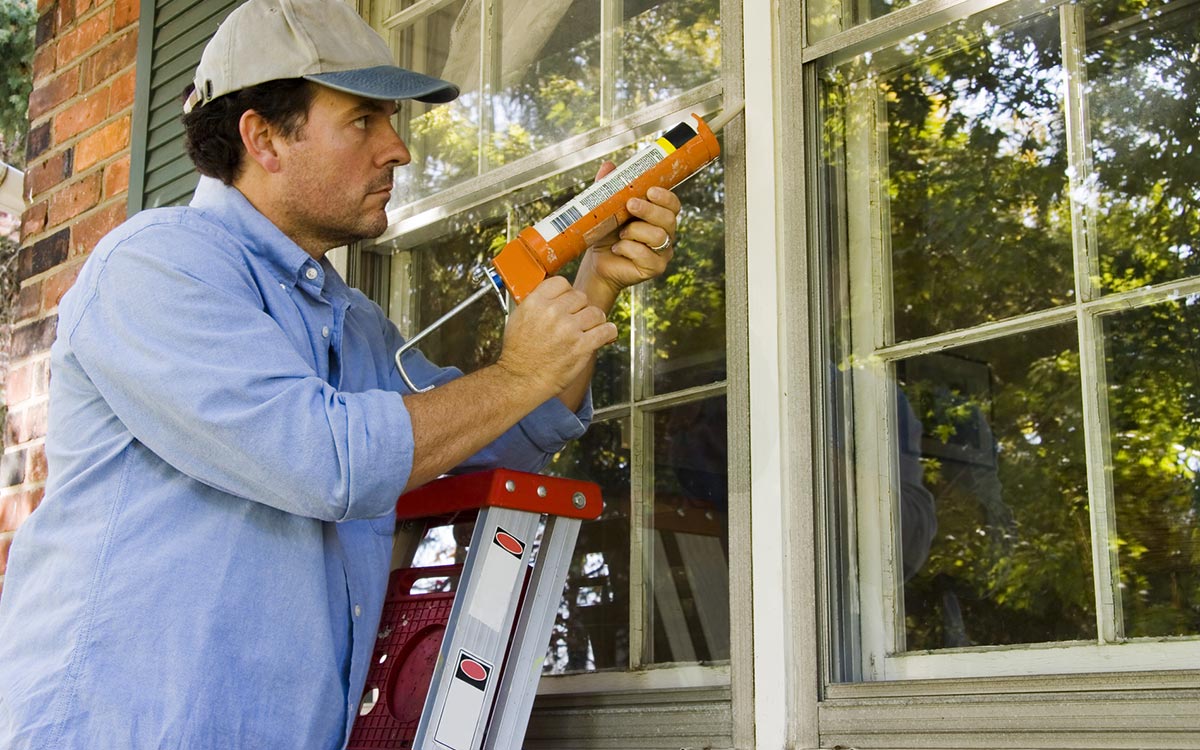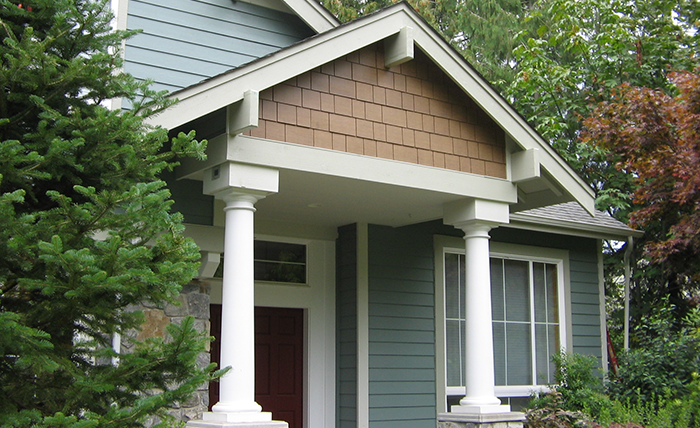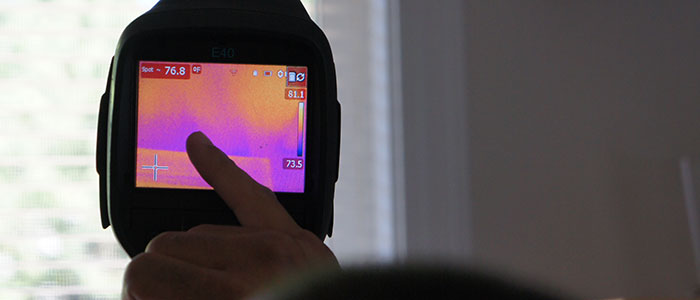
5 basics about air sealing for single family homes
1. Sneaky leak spots
There are more places where air leaks in and out of your home than you may be aware of. Most people recognize that air leaks around windows and doors, but this illustration from the Department of Energy’s Guide to Air Sealing*, shows 19 areas of the home where measurable air leaks can affect air quality and energy loss. For example, did you know that air leaks around every single electrical outlet and switch plate in your house?

2. Find a balance with fresh air allowance
Every penetration through the sides, roof or underside of your home has the potential to leak if not sealed properly. That includes windows, doors, vents, pipes, electrical cords, hose bibs and more. But before you seal, you must determine how much fresh air is needed to ensure healthy indoor air quality and ventilation of combustion equipment. Without proper ventilation, harmful gases could remain in your house (such as carbon monoxide) and/or water vapor could accumulate presenting a danger from mold and mildew. When we talk about “combustion equipment”, this includes anything that burns a fuel, whether that is natural gas, propane, or wood. Examples are:
- Furnace
- Washer /dryer
- Gas stove
- Fireplace
- Water heaters
3. Weather stripping
The easiest Do-it-Yourself leak fixes are weather stripping doors and caulking windows. Materials to do weather stripping and window caulking can be purchased from most hardware stores and applied by the homeowner. Most window companies require caulking to be done in order to maintain warranties for their windows. So it’s a good idea to do it annually, or at least check it for wear annually. Caulking around flues, vents and pipes is recommended to be done by a professional contractor using caulking materials that are safe for the application.
4. The fireplace culprit
Your windows and doors may be closed and sealed, but there may be another big hole open for air to escape. Fireplaces can leak through the flue not closing tightly, through small cracks in the masonry chimney, or from the penetration of the chimney through the roof. During a home energy audit, air leaks from your chimney will be identified, but beyond that, chimney inspection should be performed on a routine basis, if only to make sure animals haven’t nested in it. The National Fire Protection Association says “chimneys, fireplaces and vents should be inspected at least once per year for soundness, freedom from deposits and correct clearances”.
5. Fact check from other experts
According to the US Department of Energy “air sealing is one of the most cost-effective ways to improve the comfort and energy efficiency of your home. Hire a certified professional contractor for best results”. We didn’t make that last part up.
Consider a home energy audit
A certified home energy auditor is trained to assess the air sealing and ventilation needs of your home. They use technology such as blower doors tests, infrared cameras and other measures to locate sources of air leakage and ensure adequate ventilation. The auditor is trained to look for safety and health issues, and local building codes. Why does this matter? Because you can actually over seal your house, locking in carbon monoxide from gas appliances.
Washington Energy Services provides BPI certified home energy audits and air sealing services. Learn more and see if your home might benefit from an audit.
* Source “Retrofit techniques and technologies: Air Sealing – A guide for contractors to share with homeowners,” Vol 10., Building America Best Practices Series, Prepared by Pacific Northwest National Laboratory and Oak Ridge National Laboratory for the US Dept. of Energy (April 12, 2010)
- AC
- AC Installation
- AC Units
- AFUE
- air conditioner
- air conditioning
- air conditioning maintenance
- air conditioning service
- air conditioning tune-up
- air duct
- air duct cleaning
- air handlers
- air pollution
- Air Purification System
- air purifier
- Air Sealing
- angie's list
- award
- BBB
- BBB Accredited Business
- before and after
- Best air conditioner
- best filters
- best generator
- best water heater
- best window install
- boilers
- bryant
- Bryant AC
- bryant furnace
- bryant heat pump
- clean air
- combi-boiler
- comfort
- contractor
- contractors
- Cooling
- daikin
- deals
- discounts
- DIY
- door replacement
- Door Transformations
- doors
- drafty home
- drain cleaning
- Duct Cleaning
- Duct Cleaning Services
- ductless
- Ductless heat pump
- ductless heat pump. mini-split
- Ductless heat pumps
- ductless heating systems
- ductless installation
- Ducts
- earth day
- eco friendly
- EER
- election
- electrical inspection
- energy
- energy conservation
- energy efficiency
- energy efficiency rebates
- energy efficient home
- energy efficient hvac
- energy efficient HVAC Systems
- energy efficient windows
- energy myths
- energy saving
- energy saving home products
- energy star
- energy tax credit
- environmentally friendly
- exterior doors
- fall
- fall weather
- fiber cement
- filter
- filter change
- financing options
- fireplace
- fireplace insert
- furnace
- furnace filters
- furnace install
- furnace maintenance
- furnace mileage
- furnace problems
- furnace replacement
- furnace service
- furnaces
- gas fireplace
- Gas Fireplace Makeover
- gas furnace
- generators
- going green
- good business practices
- Guardian Maintenance Club
- heat
- heat pump
- heat pump installation
- heat pump maintenance
- heat pump vs ac
- Heat Pumps
- heat pumps maintenance
- heat wave
- Heating
- heating and cooling systems
- Heating Brands
- Heating Control
- Heating equipment
- Heating System Tuneup
- heatwave
- HEPA filter
- history
- holiday
- home
- home buyer
- home energy
- home energy efficiency
- Home energy efficiency solutions
- home exterior
- home heating
- home improvement
- home improvement repair
- home inspection
- home maintenance
- home maintenance checklist
- home performance
- home protection
- home repair
- home safety
- home upgrades
- home value
- home windows
- homeowners
- honeywell
- hot water
- hot water heater
- how to
- HVAC
- HVAC Contractor
- HVAC Contractors
- hvac system
- IAQ
- indoor air quality
- infographic
- install
- install furnace
- insulation
- intellihot
- light bulb
- light bulbs
- mailbag
- maintenance
- membership
- mini-split
- money saving
- navien
- new door installation
- new home
- New homeowner
- new windows
- news
- pacific northwest weather
- patio doors
- pets
- plumbing
- plumbing inspection
- power
- power outages
- precision tune up
- preventative
- Pro Tips
- Programmable Thermostats
- propane
- PSE Energy
- PUD
- Ratings
- rebates
- refund
- REME Halo
- remodeling hacks
- Replacing Heating System
- reputation
- Safe Home Insulation
- sale
- save energy
- Saving money
- scam
- scams
- seattle
- Seattle Weather
- SEER
- service
- services
- Smart thermostat
- smoke
- Solar Attic Fan
- solar power
- spring
- standby generators
- summer
- summer fires
- Summer heat
- Summer home
- super service 2016
- tank water heater
- Tank water heaters
- tankless tune ups
- tankless water heater
- tankless water heaters
- tax rebate
- tips
- tune-up
- upgrade
- upgrade cooling
- upgrade heating
- utility rebates
- Washington Energy
- washington energy services
- water conservation
- Water Heater
- water heater installation
- water heater maintenance
- water heater repair
- water heaters
- weather windows
- Wildfire Season
- wildfire smoke
- window
- window energy efficiency
- window install
- window maintence
- window remodel
- window repair
- window replacement
- windows
- winner
- winter
- Air Conditioning
- Air Purifiers
- Cooling
- Doors
- Ductless heat pump
- Environmental
- Fireplace
- Furnace
- Gas fireplace
- Generators
- Heat pump
- Heating
- Home improvement
- How to
- HVAC
- Indoor Air Quality
- Insulation
- News
- Plumbing
- Rebates
- Seattle
- Service near you
- Siding
- Tank water heaters
- Tankless water heaters
- Tips to save money
- Uncategorized
- Wildfire Season
- Windows

